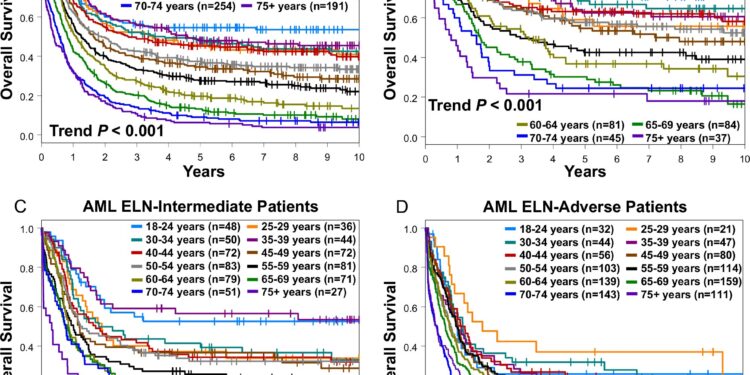Overall survival (OS) of patients in the two cohorts divided by age groups. A OS of all patients. B–D OS of patients assigned to ELN 2022 genetic risk groups: B favorable, C intermediary and D negative. Credit: Leukemia (2025). DOI: 10.1038/s41375-025-02644-0
An international study led by the Alliance for Oncology Clinical Trials and the Acute Myeloid Leukemia Cooperative Group reveals that age-based classifications in the treatment of acute myeloid leukemia (AML) may be outdated and overly simplistic.
AML is a rapidly growing cancer of the blood and bone marrow that disproportionately affects older adults. Historically, age has been a key factor in determining treatment intensity, clinical trial eligibility, and access to targeted therapies. However, this new research suggests that age alone is not a reliable indicator of a disease’s biology or prognosis.
“Our findings support a more flexible, biology-driven approach to AML treatment and trial design. Age alone should not be a gatekeeper to potentially life-saving therapies,” said Alliance researcher and senior author Ann-Kathrin Eisfeld, associate professor of internal medicine and director of the Clara D. Bloomfield Center for Leukemia. Outcomes Research at Ohio State University.
“Our findings suggest reconsidering age-based eligibility criteria for treatments. By focusing on molecular and genetic profiles rather than chronological age, clinicians can better tailor treatments to each patient, thereby improving outcomes and expanding access to new therapies.”
Published in LeukemiaThe study analyzed data from 2,823 adult AML patients treated in front-line large cooperative group trials in the United States (CALGB/Alliance) and Germany (AMLCG), revealing nuanced age-related trends in genetic mutations and survival outcomes that challenge current clinical practices. This research is the first large-scale transcontinental study to analyze mutational patterns and outcomes in patients of all ages with AML.
The analysis included patients treated with first-line cytarabine-based chemotherapy between 1986 and 2017. Molecular profiling was performed using targeted sequencing platforms and survival outcomes were assessed using the European LeukemiaNet (ELN) 2022 genetic risk classification.
The study found no clear age threshold that could biologically or prognostically divide patients into distinct groups. Instead, genetic mutations and survival outcomes varied continuously by age. This challenges the long-standing practice of using arbitrary age limits, such as 60 or 65, to guide treatment decisions.
Survival outcomes also declined steadily with age, even among patients classified as having favorable genetic risk. For example, patients aged 18 to 24 with favorable-risk AML had a five-year overall survival rate of 73%, while those aged 75 and older had a survival rate of only 21%. This trend was consistent across all risk categories, indicating that age has a negative impact on prognosis, regardless of genetic classification.
“This research comes at a critical time in oncology, as precision medicine continues to transform cancer care,” added Dr. Eisfeld. “Most targeted treatment options are still only available to patients above a certain age threshold dictated by the corresponding inclusion criteria of pivotal clinical trials, although patients outside this age range could also benefit from these often less toxic treatments.”
More information:
Monica Cusan et al, Multidimensional analysis of adult acute myeloid leukemia across continents reveals age-associated trends in mutational landscape and treatment outcomes (Acute Myeloid Leukemia Cooperative Group & Alliance for Clinical Trials in Oncology), Leukemia (2025). DOI: 10.1038/s41375-025-02644-0
Provided by the Alliance for Oncology Clinical Trials
Quote: International study challenges age-based treatment decisions in leukemia (October 14, 2025) retrieved October 15, 2025 from
This document is subject to copyright. Except for fair use for private study or research purposes, no part may be reproduced without written permission. The content is provided for informational purposes only.



